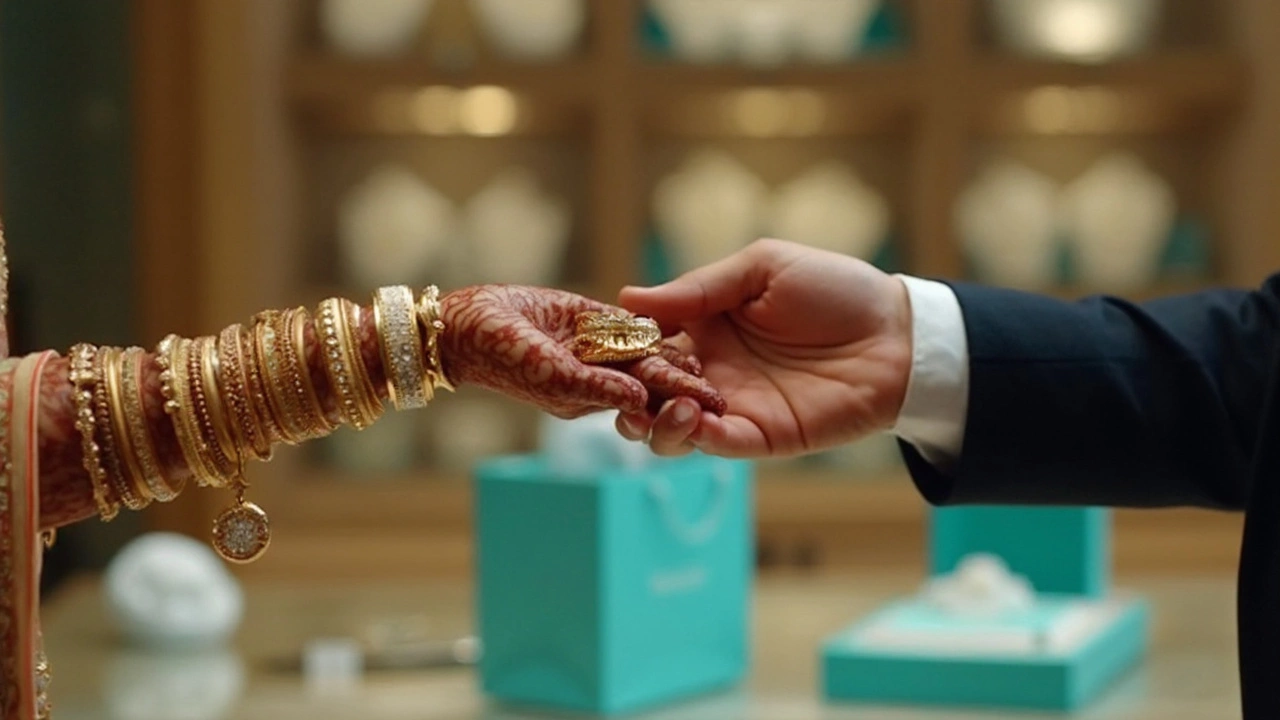
Tiffany rings have this almost magical aura—people see that blue box and instantly think 'luxury.' But does that built-in prestige actually mean the ring will keep its value if you ever decide to sell it?
Let’s cut through the hype. Not every big-name piece ages like a fine wine. Some jewelry can lose value quick, while others hold strong. It comes down to several factors: the materials, demand, condition, and of course, that little splash of brand power Tiffany brings. For gold rings in particular, prices can shift based on gold’s market value, but the brand and design add another layer you can’t ignore.
If you’re thinking of investing in a Tiffany ring or maybe selling one you’ve had sitting in a drawer, it’s a smart move to get the facts first. Is it the design, the craftsmanship, or just the name that makes it worth more? And do people actually pay good money for used Tiffany rings, or is it mostly legend? You might be surprised by what really drives the resale market.
- What Sets Tiffany Rings Apart
- How Value Is Determined in Jewelry
- Real-World Resale: What Tiffany Rings Fetch
- Tips for Buying and Selling Tiffany Rings
- Common Myths and Mistakes
What Sets Tiffany Rings Apart
So, what actually makes Tiffany rings stand out from all the gold jewelry out there? First, you can’t ignore the reputation. Tiffany & Co. isn’t just another jeweler—it’s pretty much the face of classic luxury. When you buy a Tiffany ring, you’re getting more than just a chunk of gold or a shiny diamond. You’re getting a brand with serious history; we’re talking since 1837.
Now, let’s talk materials. Tiffany is picky about what goes into their jewelry. Their diamonds, for example, are known for being top quality—always rated “Excellent” on the cut, and often coming with a laser-engraved certificate number. For gold jewelry, Tiffany uses 18k or sometimes platinum, which are considered the best for both color and durability. None of that generic gold here.
Here’s a quick breakdown comparing the qualities that matter:
| Feature | Tiffany Rings | Typical Gold Rings |
|---|---|---|
| Gold Purity | 18k (75%) | 10k–14k (41–58%) |
| Diamond Cut | Always “Excellent” | Varies, sometimes “Good” or lower |
| Brand Prestige | Global status | Usually local or none |
| Unique Designs | Signature collections | Mass market styles |
The design side can’t be overlooked either. Those signature settings—like the Tiffany Setting, which makes diamonds look bigger and brighter—are copied everywhere, but never quite matched. Plus, because every ring is made in-house, you get consistent detail that’s hard to find elsewhere.
Don’t forget the paperwork. Every real Tiffany ring comes with a certificate and can be traced back in their system, which helps when reselling. So, whether it’s the craftsmanship, materials, or pure brand influence, Tiffany rings just bring more to the table than random gold jewelry. That’s what helps them stand out and can influence if—and how well—they keep their value.
How Value Is Determined in Jewelry
If you’ve ever wondered why some rings fetch way more money than others, there’s real logic behind it. It’s not just about how shiny or pretty a piece looks. The value of Tiffany rings or any high-end gold jewelry depends on a few main things.
1. Materials matter most. Gold is the backbone, and the higher the karat (like 18k versus 14k), the more naturally valuable the piece is. Tiffany uses top-quality metals and gems, which already puts their rings a step ahead of standard jewelry. For diamonds, the "4 Cs"—carat, cut, clarity, and color—still rule the game. You can get an appraisal, but market price for gold and stones shifts daily, so timing counts.
2. Craftsmanship and brand power. It’s not just about the gold weight. With Tiffany rings, you’re paying for precision. Each ring is designed and put together by skilled people. The brand’s strict settings make stones less likely to fall out, and their styles are instantly recognizable. That reputation makes buyers pay a premium—even if the scrap value is lower than the purchase price.
3. Condition is huge. Scratches, resizing, or missing certificated paperwork can tank value. A mint ring in the signature blue box can sometimes bring in up to 30% more than one without. Buyers and resellers both obsess over the little stuff.
4. Rarity and demand. Limited edition designs and rings from collaborations with famous designers are gold for collectors. A classic solitaire is easy to sell, but unique designs sometimes get a bidding war going.
Here’s a simple breakdown of how different factors weigh in for a used Tiffany ring on the resale market:
| Factor | Impact on Value |
|---|---|
| Gold weight/purity | High |
| Diamond/gem quality | High |
| Brand and provenance | Very High |
| Condition | High |
| Original packaging/paperwork | Medium |
| Rarity of design | Medium-High |
Long story short: with Tiffany rings, you’ve got more going for you than just raw gold or gem content. The brand, the details, and the story behind the piece are what really pump up the value if you ever need to sell or trade up.

Real-World Resale: What Tiffany Rings Fetch
So, how much can you realistically get if you sell a Tiffany ring today? Here’s the deal: if your ring is in excellent condition, and you’ve got the original Tiffany box, pouch, and paperwork, buyers are willing to pay a premium. But “premium” doesn’t always mean you’ll get back what you paid at the store. On average, pre-owned Tiffany rings sell for 40% to 70% of retail, depending on the design and market demand.
It’s not just about gold content. The style matters. Iconic collections like Tiffany’s “Soleste,” “Tiffany Setting,” and vintage designs see the strongest resale prices. Trendy or discontinued styles don’t always get the same love. Another thing? Diamonds or rare stones give a serious boost. Gold-only bands without stones usually bring in less, but the Tiffany name still helps them outshine regular gold jewelry.
A quick scan on popular resale sites like eBay or The RealReal shows that a classic gold Tiffany ring usually starts around $600 and can shoot up past $5,000 for diamond rings in sought-after settings. Rings with certificates from Tiffany or GIA (Gemological Institute of America) sell faster and at better prices.
| Ring Type | Typical Retail Price | Resale Range |
|---|---|---|
| Yellow Gold Band | $1,200 | $500 - $900 |
| Diamond Solitaire | $9,000 | $3,800 - $7,000 |
| Platinum & Diamond | $12,000 | $5,000 - $9,000 |
If you’re hoping to sell, timing matters too. Right after a collection gets discontinued or during big anniversaries, prices may jump as collectors compete. The worst mistake? Selling to gold buyers or pawn shops. They’ll give you scrap value, ignoring the jewelry value Tiffany brings. Find a reputable luxury reseller or consider a private sale. Keep all your packaging and paperwork handy—they bump your payout more than you’d think.
Tips for Buying and Selling Tiffany Rings
When you’re thinking about jumping into the world of Tiffany rings, it pays to be smart and a bit cautious. These pieces aren’t cheap, and there’s real money on the table—whether you’re buying or selling. Here’s what actually matters.
Buying Tiffany Rings
- Check for Authenticity: Always ask for a certificate. Real Tiffany rings come stamped with the brand’s logo, and legit sellers can show papers or receipts. Fakes are everywhere online and sometimes look convincing, so buy from Tiffany & Co. stores, certified resellers, or trusted estate jewelers.
- Condition Counts: Scratches, missing stones, or non-original parts lower the price fast. Try to buy rings in ‘like new’ shape—those tend to hold their resale value best.
- Popular Designs Move Faster: Styles like the Tiffany Setting or the Soleste often resell better than random custom pieces. If you want something to potentially sell later for a high price, stick to the big names.
- Don’t Skip the Box: Keeping that iconic blue box and pouch boosts value—buyers love the full package.
Selling Tiffany Rings
- Know Your Numbers: Used Tiffany rings typically resell for 40-70% of their original retail price, depending mostly on condition, model, and market demand. For example, a recent survey from a top secondhand diamond site found the average Tiffany engagement ring fetched around 60% of its original price if in top shape.
- Get a Real Appraisal: Don’t just guess. Jewelers or reputable resale sites can give you a clear value based on gold content, stones, and market trends. This makes sure you don’t underprice (or scare off buyers by overpricing).
- Use Trusted Resale Platforms: eBay, The RealReal, Circa, and Worthy are popular choices, but look for sellers with great reviews and real verification processes. Some sites will even ship and insure your item for free, cutting your risk.
- Highlight the Features: When selling, call out everything special: gold karat, total carat weight in stones, year bought, original paperwork, and whether you have the box.
| Resale Factor | Typical Impact on Value |
|---|---|
| With Original Box & Papers | +10-20% |
| Popular Models (e.g., Tiffany Setting) | +15% |
| Visible Wear or Damage | -20% or more |
| No Certificate | -10% to -30% |
Bottom line—whether you’re buying or selling a Tiffany ring, details matter. Documents, condition, and choosing the right time and platform can make a big difference in how much money you keep in your pocket. Look at it like you would any big purchase or sale: do your homework, double-check everything, and don’t be afraid to ask for proof or haggle if it doesn’t meet the usual gold jewelry standards.

Common Myths and Mistakes
There’s a lot of talk online about Tiffany rings and their value—some true, some way off the mark. Let’s dig into a few of the biggest myths people fall for, and the costly mistakes you can avoid.
Myth #1: Every Tiffany ring always goes up in value. This just isn’t how things work. The truth is, most Tiffany rings will hold their value better than no-name pieces, but only certain styles—especially rare or vintage designs—see any real increase. Everyday gold ring designs or recent releases might fetch less on resale, sometimes just 50–70% of retail, depending on the condition and market demand.
Myth #2: The brand alone guarantees top dollar. Name matters, but not as much as you think. Buyers look for condition, original packaging, and paperwork. If you’ve lost that little blue box or the certificate, you might get significantly less. Clean rings, with minimal scratching and authentic hallmarks, always get more attention and better offers.
Here’s where people slip up most often when dealing with resale:
- Not checking current gold prices before selling a Tiffany ring—sometimes it’s smarter to wait.
- Assuming all designs are in demand—some classic or discontinued styles just attract more buyers.
- Listing rings without clear photos, certificates, or proof of authenticity—most serious buyers want records and clarity.
- Selling to random online buyers without checking their reputation—there are scams out there, and fake offers happen.
- Skipping professional cleaning—rings look much better to buyers when they sparkle, and you’ll often get a higher price.
For a clear look at how value can really change, check out this sample of resale data from late 2024:
| Type of Tiffany Ring | Original Retail Price | Average Resale Price |
|---|---|---|
| Basic Gold Band | $1,500 | $900–$1,100 |
| Vintage Elsa Peretti | $2,200 | $1,900–$2,600 |
| Modern Solitaire | $5,800 | $3,200–$4,000 |
If you want your gold jewelry or Tiffany rings to stand the test of time when it comes to holding value, focus on keeping everything in great shape, holding onto boxes and paperwork, and only selling through reputable channels.




